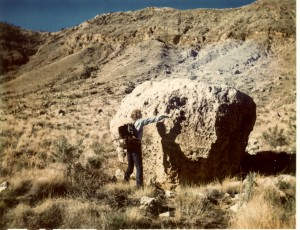What studying geology taught me about the world.
I came to the University of Arizona intending to study the geology of the moon.
And I did.
But what I came away with more importantly was a profound education that would impact the way I’ve thought about everything ever since.
One of the teachers I expected the least of and who taught me the most was a geochronologist named Terah Smiley.
Geochronology is the study of figuring out the time sequence of the earth, its strata and soils. It’s complex yet simple stuff.
I remember Dr. Smiley asking us what radiocarbon dating was. And we offered our answers, most centering on some permutation of the idea that one could determine the age of some carbon-based material by measuring the ratio of two carbon isotopes.
We came at it from every direction, and Smiley kept saying, “No.” It was a measurement of the two isotopes, one of us said. “No,” he again replied, puffing on his pipe. This went on for quite a while as we racked our brains to figure out what we could possibly have wrong.
Eventually we were stumped and fell silent.
“it’s what some scientist claims to have measured,” Smiley eventually revealed. He might be wrong in his measurement, or he might out and out have lied.
“You have to be skeptical,” he insisted. “Make them prove it. You have to independently verify those results.”
I watched Smiley make some of the best minds in geology squirm like 5 year olds at the weekly geology colloquia as they delivered their research papers. Not just students but acclaimed professors from around the world. Smiley had a way of cutting the crap that was impossible to walk away from unshaken if there was any weak point in your scientific argument.
It was one of those things I’ve carried with me throughout my life. It served me well when I was a journalist, as people lied to me outright or came to believe some fairy dust notions fairly routinely.
My own business of reviewing music was likewise highly subjective, and sometimes I would find myself thinking, “What would Dr. Smiley say about this?”
My days as a geologist were an integral part of how I reviewed concerts for the Tucson Citizen. It was all about relationships. How the sound came together in a sort of continuum of time and space. A landscape, of sorts, evolving before my ears.
Were there unconformities – places where the sound just didn’t come together for whatever reason. Did something happen to the music in a broadly architectural sense that made it go awry?
Of course a lot of my writing of music was also based on style and culture, but conceptually it was always instant geology in my mind.
As a composer I still write in geologic ways.
I had another professor whose name sadly escapes me. He taught crystallography, which was something I had no interest in whatsoever until I took his course.
In one lecture he spoke about impurities in minerals and what they really were. Most of us thought they might be dirt or some debris randomly distributed. But it was anything but random.
He spoke of how in some minerals the basic crystal structure would repeat itself, sometimes hundreds of thousands of times before a single atom of the so-called “Impurity” would drop into place. And then the structure would repeat itself again precisely that same number of repetitions before another single atom would drop in place, and on and on and on. It seemed impossible to imagine but he explained that the crystal had precipitated out over an extraordinary time and that each atom had found its exactly ideal distance from the rest based on such factors as gravity, charge and relative buoyancy. It was mind blowing stuff.
He also explained how these very complex structures that seemed numerically impossible could always be reduced to a series of simpler mathematical equations acting in tandem.
It was really beyond the grasp of my imagination, but it would form the basis of one of my own guiding ideas – that the impossible could always be broken down into many possible parts.
I love that I have that geological background within me. It gives me a sense of place and wonder everywhere I travel as I try to unravel what had happened in a geological sense as I pass various rock cuts along the highway or look out over mountains, valleys, rivers and the like. There’s always something more to discover.
I suspect it is a huge part of my fascination with photographing landscapes, which also manifests itself in video time lapse photography. In time lapse, the desert seems upside down and the river runs fluidly across the sky. I am as drawn to the sky and clouds as to the desert terrain and unique plant life.

